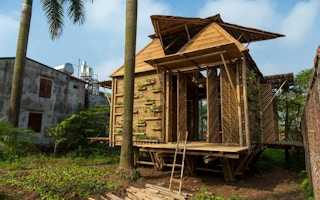Vietnamese firm H&P Architects has built a low-cost sustainable housing prototype that will withstand natural disasters in typhoon-prone Vietnam.
To continue reading, subscribe to Eco‑Business.
There's something for everyone. We offer a range of subscription plans.
- Access our stories and receive our Insights Weekly newsletter with the free EB Member plan.
- Unlock unlimited access to our content and archive with EB Circle.
- Publish your content with EB Premium.
Called the Blooming Bamboo, the thatched hut-looking house is constructed mainly with bamboo and other locally sourced materials to create a structure that not only promotes vernacular architecture, or architecture rooted in cultural traditions and basic use of natural resources, but also prevents property damage during flooding in the country.
The architectural firm aims to address the impact of severe calamities, such as storms, flash floods, landslides and droughts, which result in about 500 lost lives and a 1.2 per cent reduction in the gross domestic product of Vietnam every year, said H&P Architects.
Just this Tuesday, five people were reported dead in Vietnam, along with 58 Chinese fishermen missing in the South China Sea due to Typhoon Wutip, according to China’s Xinhua news agency. Winds of up to 103 kilometres per hour destroyed the roofs of about 95,000 houses, as well as hectares of agricultural land.
“
The house can warm people in the most severe conditions and help them control activities in the future, also remarkably contribute to ecological development as well as economic stabilization
H&P Architects
The two-storey, 44-square-metre Blooming Bamboo has a fixed bamboo frame raised on stilts, and it can withstand 1.5 metres of high floods, lead architect Doan Thanh Ha said in their company Facebook page.
They are currently experimenting with a model that is strong enough to resist the impact of a three-metre-high flood, he added.
The Blooming Bamboo prototype, located at Cau Dien Town in Ha Noi, is built simply by bolting, binding, hanging and placing numerous bamboo modules, creating a pulled monolithic or one-material type of architecture, the firm said. Although monolithic architecture often refers to use of rocks as in prehistoric structures or concrete such as in monolithic domes, such a construction method allows for flexibility and convenience in difficult geological conditions or situations. There is freedom to quickly adjust configurations or adapt to the site.
Other materials like bamboo wattle, fibreboards and coconut leaves can also be added, said the firm. The house costs only US$2,500, is easy to construct and can be completed within 25 days.
H&P Architects also developed the Blooming Bamboo in such a way as to accommodate mass production. The space, which comes complete with living room, bedroom and bathroom, kitchen, laundry and drying area plus an indoor terrace for learning or worship and an animal shelter or plant breeding area by the stilts, is multifunctional so it can be converted as an educational, medical or community center. It can also be expanded if required.
“The house can warm people in the most severe conditions and help them control activities in the future, also remarkably contribute to ecological development as well as economic stabilization,” said the firm.










